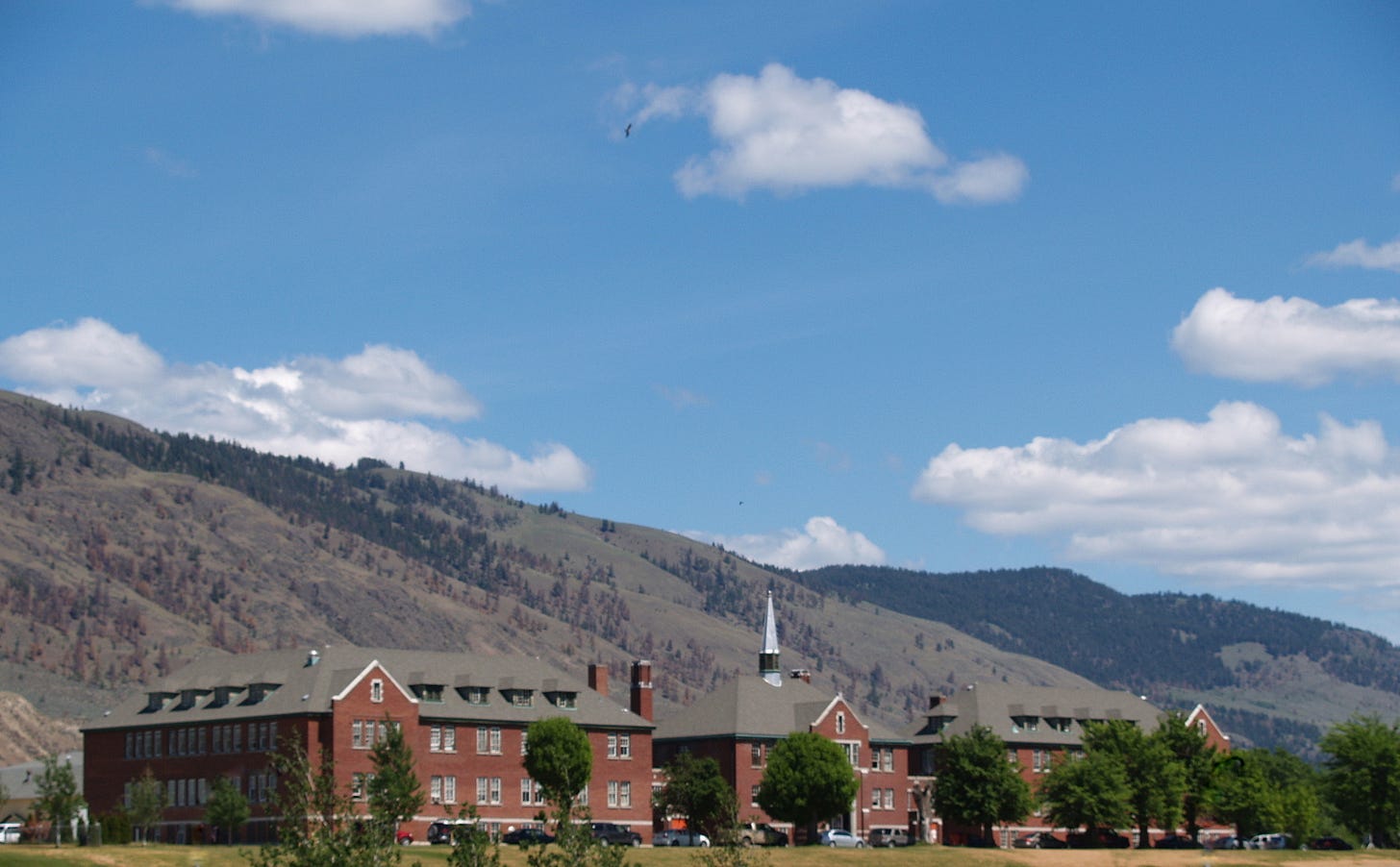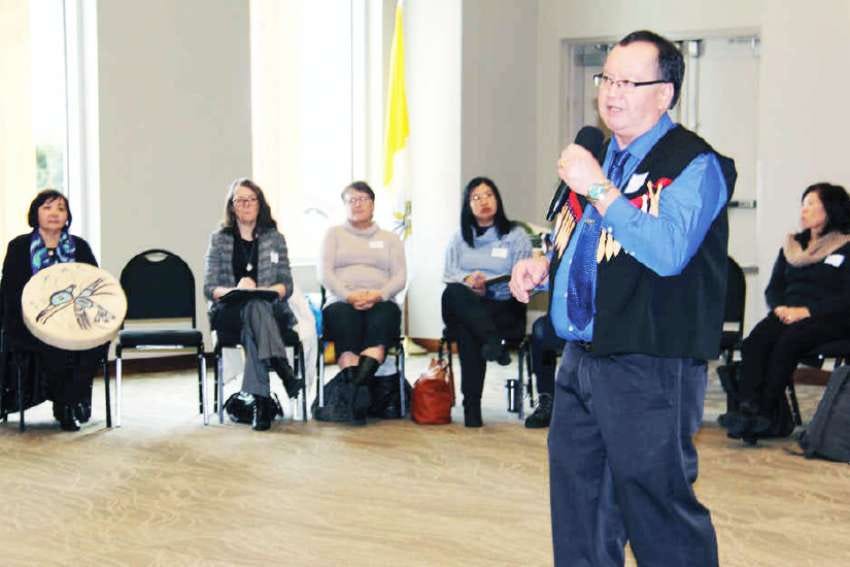The Cowessess First Nation announced last week that at least 751 unmarked graves have been identified on the grounds of the Marieval Indian Residential School in Saskatchewan, Canada. The announcement comes less than a month after the remains of 215 children were confirmed to be buried at Kamloops Indian Residential School in British Columbia.
Confirming the presence of those unmarked graves has spotlighted a great wound in Canada’s history: the residential school system. Between 1863 and 1996, more than 150,000 children attended residential schools, most of which were administered by Catholic, Anglican, and other religious groups. Until 1948, attendance for many tribal children was mandatory.

The residential schools were part of a set of policies which amounted to “cultural genocide,” according to the Truth and Reconciliation Commission’s (TRC) 2015 final report on the residential school system. Compulsory attendance ended in 1948, and the schools began to close mostly in the 1960s, but some stayed open for decades longer.
Archbishop Richard Gagnon of Winnipeg, president of the Canadian Conference of Catholic Bishops (CCCB), responded in a May 31 statement to the Kamloops discovery.
“As we see ever more clearly the pain and suffering of the past, the Bishops of Canada pledge to continue walking side by side with Indigenous Peoples in the present, seeking greater healing and reconciliation for the future,” he said in the statement.
But what does “healing and reconciliation” really look like?
As the Church promises its efforts, some local leaders ask what those efforts will entail - and what their effect will be.
Deacon Rennie Nahanee, who is both a Catholic deacon and an elder of the Squamish Nation, told The Pillar he appreciates that Gagnon talks about “walking” with the indigenous leadership in Canada.
But practically, Nahanee said, “What does that even mean? You know, I like to go for walks, too, but it's usually for two hours.”
When the TRC published its final report in 2015, it also released a list of 94 calls to action to assist in the reconciliation process between the indigenous peoples and Canadians.
That list called for specific measures to be taken by the Church, including a papal apology. The final report also urged the Canadian government and Canadian churches to take their lead from indigenous communities in a process of healing.
Nahanee, a deacon of the Archdiocese of Vancouver who previously worked in the archdiocesan First Nations Ministry office, believes the Church has largely followed the proposed calls to action since they were published in 2015.
Dioceses across Canada, as well as the CCCB, have held listening sessions and formed relationships to hear the needs of indigenous communities.
Still, he said, the impact of the residential schools was huge, and it continues to be felt.
According to the Canadian Conference of Catholic Bishops, approximately 16 out of 61 Roman Catholic dioceses in Canada were associated with the residential school system, as were about 36 out of over 100 Catholic religious orders in Canada. By some estimates, as many as 70% of the roughly 130 residential schools were connected to the Catholic Church.
Nahanee said the purpose of residential schools was to “take the Indian out of the child.”
“This meant getting rid of our culture, the language, the spirituality, and pretty much made them, when they returned to the reserves, kind of like pariahs.”
That cultural experience continues to shape liturgical celebrations in some indigenous communities, he said.
The deacon is among several Catholics who have said that reconciliation would be served by an effort to incorporate indigenous cultural symbols and languages into Catholic liturgies.
“The Church is in our territory. And yet, they have not budged to accommodate us when it comes to our language and our culture in the Church. It’s kind of like, ‘Welcome to our Church, but leave your drums and drumsticks at the door.’”
Incorporating indigenous culture
The call to bring indigenous culture into the Church’s life and liturgy resonates with Father Ken Thorson, provincial of Missionary Oblates of Mary Immaculate’s Lacombe Province, which ran the Kamloops school where the presence of unmarked graves was confirmed earlier this year.
The Oblates released a statement in May voicing distress and regret at news. The statement said the Oblates promise to “listen deeply and learn from indigenous communities” as they move forward.
“For too long, (the Canadian government and Church) were the ones who gave directions, who made decisions,” Thorson told The Pillar. “It was too often the case that these decisions impacted negatively the culture and community of indigenous peoples across the country.”
Thorson said that searching for ways to incorporate indigenous traditions and ritual into Catholic ritual - whether the Mass or another form of Catholic prayer - is a priority. His Oblate province ministers in around 20 places which serve primarily indigenous communities, making it especially important for him to ensure indigenous cultures are expressed in the Church’s life.
“The Holy Spirit was present in and interacted with indigenous peoples before the Oblates or Christianity ever came to Canada,” Thorson said. “The Church needs to be in conversation with indigenous history, ritual and tradition, (and) learn of God from it … so that the prayer of these places can be reflective of the people’s experience of God.”
A few elements of indigenous cultures have been incorporated into the Mass already.
Deacon Nahanee said he holds a talking stick - used ritually to designate the person who has the right to speak at a specific time - when he proclaims the Gospel or gives a homily at Mass.
At his parish, the Lord’s Prayer is recited in the Squamish language, and some elders wear traditional clothing on feasts or at other special Masses.
Ideally, Nahanee said, he would like to see a full translation of the Mass into indigenous languages that could be included in the Sunday missal, or even an indigenous rite. Not only would it be a sign of goodwill, but walking into a church and recognizing one’s language and culture could become a tool for evangelizing to non-Catholic indigenous and those who have stopped practicing the faith, he said.
Nahanee told The Pillar he has heard indigenous people express similar desires in talking circles and listening sessions throughout the country.
“It’s a litmus test (for bishops),” said Nahanee. “Are they really going to walk with us and ask us what we want as Catholic indigenous people? (Or do) they not want their liturgy tainted by drumming and singing and our language being used in church? We need the bishops’ support in this, because we’d have to get this okayed by the Vatican.”
An apology from Pope Francis, on Canadian soil
That appeal to Rome might come sooner than expected. In a June 10 statement, the CCCB committed to presenting a delegation of elders/knowledge keepers, residential school survivors and youth from across Canada to meet with Pope Francis by the end of 2021, as long as international travel guidelines permit it.
This delegation has been in the works for many years, Archbishop Gagnon told The Pillar, but was delayed by the COVID-19 pandemic. When the trip comes to fruition, it will allow the pope to hear directly from members of indigenous communities and address the trauma and the ongoing issues related to the Church’s historical actions in Canada.
The TRC called in 2015 for an apology from the pope, similar to the apology made by Pope Benedict XVI to Irish sex abuse survivors in 2010. Many in Canada have wondered why Pope Francis hasn’t made such an apology yet, especially after the news from Kamloops and Marieval has captured global attention, Nahanee said.
The pope did issue a statement during his June 6 Angelus message regarding the graves in Kamloops.
Gagnon, who has been president of the CCCB since 2019, said the pope hasn’t made an explicit apology not because he doesn’t want to, but because “reconciliation isn’t just a matter of ticking off a box.”
Referencing Pope Francis’ 2015 apology in Bolivia for the Church’s “grave sins” against Bolivian native peoples, Gagnon said the pope is “very open” to an apology.
But the pope “also realizes you can’t just make an apology from a window someplace where there’s no Aboriginal people,” the archbishop told The Pillar.
“The Holy Father said three years ago he’s open to coming to Canada at an opportune time,” said Gagnon, adding that he’s spoken multiple times to Pope Francis about the issue.
“He is very interested in this question of reconciliation (and) the needs of Aboriginal people.”
Nahanee believes such an apology is needed and should be made in Kamloops, but that it should be more than a repetition of apologies already made by the Catholic community in Canada for it to be effective.
“What do you want the Church to do to make amends for what it’s done to indigenous people? How can we atone for that? That’s what I want to hear,” Nahanee said.
Moving forward
Nahanee said he is one of many indigienous people experiencing a tension between the Church he loves and the treatment of his people. Nahanee’s parents and older siblings were sent to residential schools, and he was angry when he heard about the graves in Kamloops.
“How can a Christian school bury children on school grounds, not even notifying their parents or community to come pick up the remains?” he said.
Nahanee said reconciliation would be helped by fostering a greater awareness of the indigineous experience.
When he worked for the Archdiocese of Vancouver, Nahanee would hold Kairos blanket exercises for his chancery coworkers, which tell the story of Canadian history from an indigenous perspective. For many, he said, it was the first time they had learned about the indigenous Canadian experience from an indigenous perspective; for many it was an emotional experience.
Archbishop Gagnon said he recognizes that the lived experience of the indigenous population is overlooked by most Canadians. There are many issues that remain, he said, including discrimination, poverty, and ongoing trauma stemming from the government’s and Church’s actions.
“There’s a lot of work that needs to be done,” the archbishop said. “It’s a matter of relationship (which comes) when there is openness and truth.”
That relationship will require the building and maintaining of trust, a task that is challenged as new graves are discovered. Although it was known that more graves existed in the country, each new confirmation is a blow to the healing and reconciliation process.
Nahanee agreed.
“I believe now that the spirits of the children are calling out to Canadians all across the land to help bring closure to the children buried in unmarked graves and closure to their families,” the deacon said.
Thorson said that for the Oblates being available and present to learn how to better serve local indigenous communities is key to their future ministry.
“We perhaps don’t even walk beside (indigenous leadership) at this moment,” Thorson said. “(We’re) a step behind, allowing the elders and leaders of the community to lead, and to help us come to an appreciation of how we can minister with them.”
Nahanee said he remains cautiously optimistic. He believes the words of the bishops when they say they want to work for greater healing, and he hopes to see actions following the words, as well as the reception of those actions by people who do not understand what indigenous people have endured.
“I believe the bishops of Canada should explain (concretely) what they mean by walking with us,” he said. “And I’m hopeful that if they want to return our language, culture and spirituality, that they will make this indigenous liturgy a reality. That would go a long way.”






